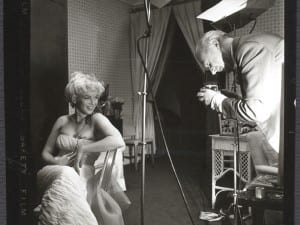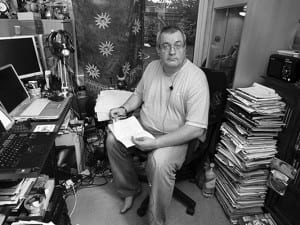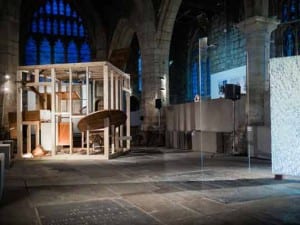Fuerzabruta returns to the Roundhouse in London, bringing with it an exciting celebration of carnival and street theatre in which reality is disregarded in favour of dreams.
The enduring appeal of theatre is the element of live performance. If you are looking for visual storytelling, cinema offers an array of incredible images, special effects and surround sound, far beyond that which the theatre is capable of producing. However, theatre has many things that film cannot currently offer: a relationship between performer and audience, the potential for something to go wrong and the possibility of change.
The audience is an absolutely vital part of live performance, in a way that it is not in film. There are productions such as Punchdrunk’s The Drowned Man (2013) in which the audience actively chooses a route through the show, but even in more linear, proscenium arch productions the spirit, mood and emotion of an audience can influence the entire experience. It’s a community, of spectacle and spectators alike. While, in the cinema the audience doesn’t need to share the experience, there is an important aspect of this relationship and community missing – the performers aren’t there.
Diqui James is the artistic director of Fuerzabruta, a multi-sensory Argentinian spectacular, and it is this social aspect of the drama arena that drives him to create the work he does: “I don’t know how you can compete with film if you use exactly the same format.” Theatre-makers, he argues, have to play to theatre’s strengths and compete with the screen through its ability to react and change, by having the audience present. It’s highly likely that in time the picture-house will offer this too – with constant leaps in technology and equipment, perhaps we will soon have interactive screen-based narratives, which combine the scale and magnificence of cinematic images with the subtle and intimate relationship between performer and audience.
For now though, this is something specific to theatre: “It is wilder and it’s alive. You bring your body to the performance.” This idea of bringing your own physicality to a show as an audience member is something that bears great relevance to Fuerzabruta, in which the audience stands for the duration of the 70-minute performance and is free to dance, move and interact at will. Coming from Argentina by way of the acclaimed De La Guarda, which ran off-Broadway for six years, Fuerzabruta was created by Diqui James and Gaby Kerpel and premiered in Buenos Aires in 2005. It has since travelled the world and returned to the Roundhouse in Camden, London, for a run of 100 shows this winter, many of which have sold out with rave reviews.
The production is the fastest-selling show in the Roundhouse’s history and features stunning visual effects and live performance including a man darting through walls, a riotous drumming band and women sprinting around the curtains at the sides. There’s no discernible narrative: it is up to the onlookers to find a story in the movement if they want to look for one. This is a show which reveals as much about the audience as it does about the creators, implying a certain autonomy. James talks about how different cultures have reacted in various ways to the surprises presented to them.
His intention, in providing unanticipated action, is to wake the audience, for them not to feel entirely safe and to feel that anything is possible: “Surprise for us is not an effect, it’s a state of mind.” It seems that he is aiming for a state of wonder: that wide-eyed delight at the colours of a fiesta. The production has its roots in carnival: “My main motivation and inspiration is festivities in the street. That’s my passion – when you see people celebrating.” The humanity of the piece is its essence. The sheer exhilaration of the running man and the women moving through the waterworld above the heads of the audience captures the raw vibrancy of the festival atmosphere, where the joy is visceral and stems from emotion, music and motion.
Fuerzabruta is often translated literally as “brute force” but James insists that sounds too violent, too military, and that it is better described as “raw power.” The stunts that the performers undertake are not unattainable – the man running, a bundle of people swinging overhead – but they do exude this urgency. For James, it is significant that the stunts aren’t skilled in the way circus is as he wants people to be able to relate to the event on a basic, physical level without the necessity of an art education or background knowledge in any specific areas. He is almost post-modernist in his approach: he is adamant that art should refer to life and not to other work and that it relates to human nature and not to intellect. “We have big social gaps in Argentina, so I wanted to do something both for someone who reads Shakespeare every day and someone who does not know how to read or write. We try to keep the attention simple and focus on human things.”
This desire to reach out to everybody can seem slightly at odds with the large-scale, expensive production he has created and James acknowledges this distance. He longs to create something performed outdoors. “It is the best place for theatre. It’s very difficult to do it in the street, of course, but I think there is the character of street theatre in what we do – a spirit of celebration.” Street theatre takes the immediacy of the art form to its zenith: a performer must adapt and improvise to capture his or her audience and retain them. The feedback is instantaneous, because if a viewer isn’t enjoying the work, they will just walk away – it doesn’t get more honest than that.
This is something that appeals greatly to James, for whom theatre is all action, and he anticipates a return to street theatre from a wide range of performers. “All of my friends who studied theatre, acting or dance were thinking in one part of their brain what they should do out there with the general public. In the 1980s it was something we were all doing. Now, though, it’s not as much a part of the conversation, but I hope that it becomes popular again.” It’s the meritocracy of this type of location, which makes it a powerful place to perform. It’s a social platform and “the good thing about theatre is that it’s not an individual experience, it’s a social encounter.”
Over time entertainment has evolved from being a shared event into being an isolated or solo one: once we read books as a group – we now read alone; we are on the computer and watch films as a solitary activity. In response to this, people are seeking new opportunities to socialise, to be part of a community, and James hopes that “the street will be reclaimed.” The increasing use of online networks and media leaves a space: it has already been filled with a popular return to knitting groups, analogue and allotments. We are perhaps less patient now than ever before and also have a greater ability to reach more people instantly. The beauty of street theatre then, is that it both embraces this new lifestyle and reacts against it.
The type of performance offers a social community in which you can act immediately: “The flip side of the isolation of the internet is that you can have 10,000 people jumping in the square at 10 o’clock tomorrow.” It’s an arena that has all the danger and joy of live performance and satisfies the need for immediate response that we’ve become accustomed to with Facebook and Twitter. “For the last few decades people have been too patient. I hope people will tire of waiting for someone to give them a theatre or the resources to do something. Stop waiting and get out there and do it for yourself.”
Fuerzabruta runs at the Roundhouse in Camden until 2March. Tickets are on a sliding scale and are cheaper than last year. For more information and tickets, please visit www.roundhouse.org.uk or call the Box Office +44 (0) 844 482 8008. Fuerzabruta is a standing show, which contains scenes of mild nudity and violence, with strobe lighting and loud music and therefore it is not recommended for young children. www.fuerzabruta.net.
Bryony Byrne





